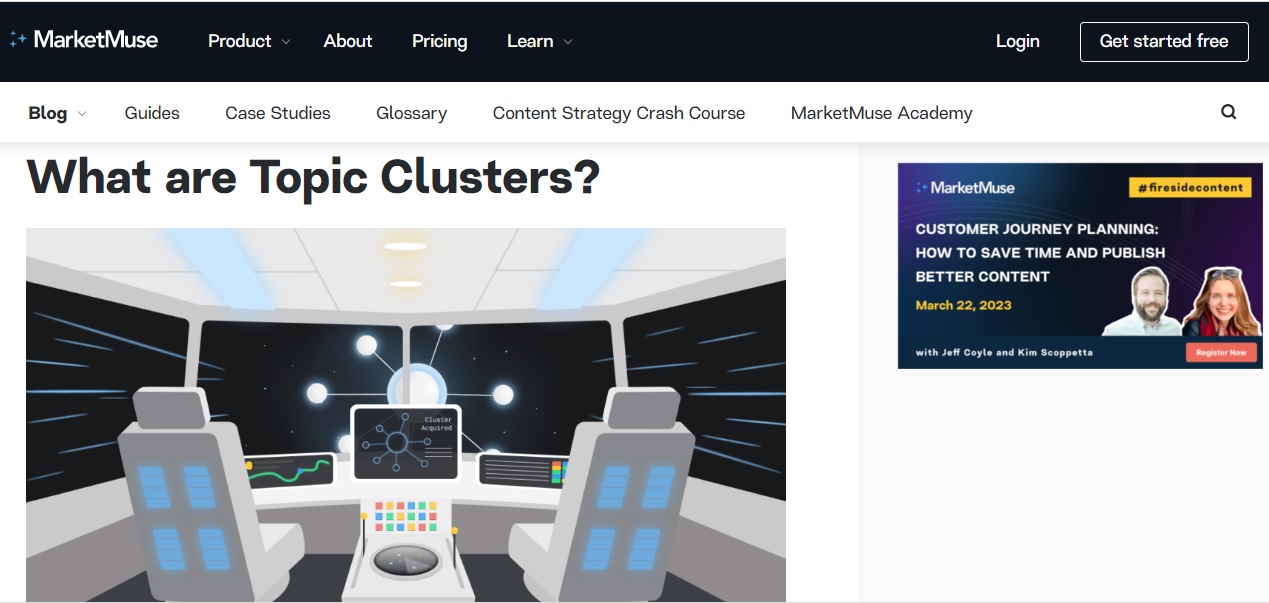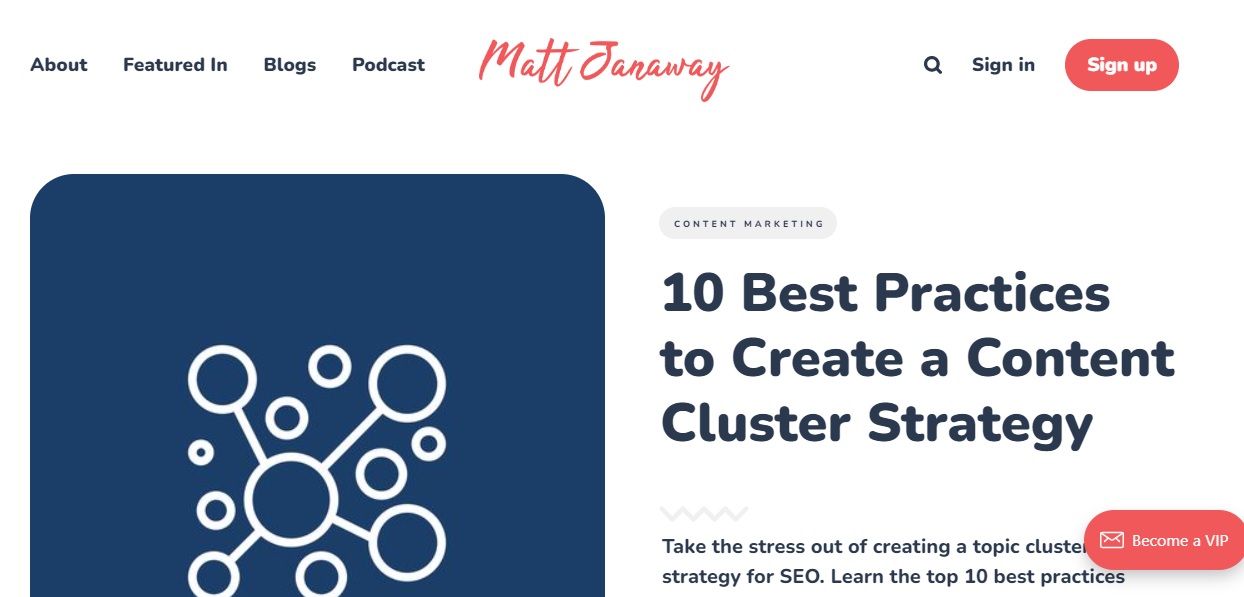Introduction
What are topic clusters? The answer is pretty simple: they’re collections of multiple pieces of content marketing centered around a shared main topic, which are, in turn, made up of related subtopics. The whole is bigger than the sum of its parts: topic clusters become entire webpages that comprehensively cover multiple aspects of any given subject.

Topic clusters pose a significant advantage in the SEO world because they stretch beyond individual keywords. Their synergistic power, as a whole, can drive visitor traffic due to how much data gets crowded in one cluster. Content marketing strategists use topic clusters to get high rankings in SERPs (search engine results pages).
You can also conceptualize topic clusters from the three components that comprise them, yielding a somewhat more nuanced and complex definition:
- Pillar page: The core page, the skeletal backbone of your topic cluster is the pillar content page. It should cover a wide variety of user intents, meaning building organic traffic and conversions with specific user intents and incentives for following through on those intents. Through your pillar content page, there’ll be a logical flow to the next piece of related content they click on, irrespective of where they are in the buying process.
- Cluster pages: These cover the subtopics, homing in on more specific and detailed aspects of narrower foci with specific user intents in mind. Cluster pages are forays into a core topic with the accompanying related content to represent it.
- Internal linking: These are the connective tissues that link cluster pages to the pillar page, signaling to search engines that the pillar page is the more important of the two and should thus be given higher weight. When you have a well-vetted piece of existing content on the pillar page, that authority transfers to the content cluster page, making the entire topic cluster a seamlessly integrated, well-oiled machine primed for SEO.
Recently, there has been a substantial shift to topic clustering to drive traffic in SEO content strategy. The reason for this is also pretty simple: competition to rank in search engines has jumped, there are both more supply and demand factors when it comes to engagement with media and making purchases, and the online economy is, therefore, a more crowded marketplace than ever before. Content-focused websites now have to rely on updated tactics to drive traffic to their site and “stand out amongst the crowd.”

Understanding and Implementing Topic Clusters
Now that we’ve both broadly and specifically defined topic clusters, it’ll be essential to understand their uses and functions on the web.
One way to start is to identify key topics for your topic cluster strategy. Here, using a buyer problem-and-solution model is particularly useful. It’s all maps these days, so map out core user problems that you want your cluster content to address. Group each of these problems into general topic areas, then subgroup these topic areas using keyword research. To address solutions, map out relevant content ideas that will solve these user problems through these general topics and specific subtopics. Vet each idea with research, generate quality content, and adjust as you go.
Understanding the benefits of using topic clusters as an SEO strategy for your content is essential. We’ve mentioned this before, but it can’t be understated: the point of topic cluster SEO strategy is to rank higher in search engine results pages, making it easier for visitors to navigate your cluster content and driving more organic traffic to your site(s). Using topic clusters will also help you get a leg up in being an authority on your content topics in your industry. Lastly, using topic clustering can help generate more internal linking opportunities.
Measuring Topic Cluster Success
Determining the efficacy of a well-implemented topic cluster is easier said than done. However, there are three basic routes you can go to do so and mine useful data as a result:
1. Use data analytics tools.
These content marketing strategy tools are built to help content creators and strategists research, plan, and execute their topic cluster campaigns. Tools like Google Analytics help by measuring the impact of topic clusters on organic traffic, the generation of new leads, and leads-to-customer conversions.
2. Track search engine rankings.
Analyzing linkbacks to pillar topic pages helps yield insight into the authoritativeness of the pillar page on a given subject. The more linkbacks, the better. You can then monitor the pillar page’s ranking over time to see general and specific trends. Stable rankings indicate a firm hold on topic authority.
3. Analyze user feedback.
Google Reviews are so important and valuable, and you can mine key data from these reviews to understand what users like and don’t like about your company. 
Best Practices for Topic Clusters
You can optimize your topic clusters through content strategy, strong internal linking structure, and using related keywords properly. Our top 5 best practices are:

- Research, research, research! Build a robust list of subtopics that can link to your pillar page to build its authority and rankings. For this strategy, using short-tail related keywords is best because they can help uncover subtopics.
- Here’s an interesting one you may not have considered: conduct a competitor analysis. This is a basic form of market research. Seek top-ranking pillar pages for other companies and modify your campaign to compete with them.
- Interlink related pages. Internal links are important substrates of topic clusters because they convert organic traffic into explorable content.
- Make your site, content, pages, keywords, and everything else mobile-friendly. The stats are out that most internet users are on mobile devices right now.
- Create multiple clusters! Showcase your company’s robustness and content in various ways to indicate its authority and foothold in its particular industry.
Conclusion
The benefits of using topic clusters as a primary SEO strategy are numerous. SEO content strategy should be built to optimize and maximize rankings, authority, and organic traffic. The way to do so nowadays is through topic clusters, which convert leads, increase your rankings, and demonstrate your brand’s authority.
We’ve also provided some tips for implementing and measuring the success of topic clusters in your own content efforts. These are the best practices of research, proper keyword use, robust internal linkings, and competitor analysis – all built on multiple topic clusters for your brand. You can learn how your topic clusters are working for you by using data analytics tools, tracking search engine rankings, and analyzing user feedback through tools like Google Reviews, which can provide a lot of insight into how your brand is perceived.
FAQs
1. What are topic clusters?
Topic clusters are collections of topics, subtopics, and links that go into showcasing your influence and authority on a specific topic.
2. Why is the trend of using topic clusters in SEO content strategy on the rise?
It’s getting increasingly difficult to operate within a saturated online market right now, so topic clusters help you get ahead and stand out amongst the crowd by demonstrating your authority on a topic, as indicated by higher rankings on SERPs.
3. How can I implement topic clusters in my content strategy?
Use the user problem-and-solution model. Make a list of user problems, break them down into components, and readily address those macro topics and their accompanying subtopics with unique content ideas.
4. How can I measure the success of my topic cluster efforts?
Using data analytics tools, tracking your own AND your competitors’ search engine rankings, and analyzing user feedback will all help you gain insight into the success of your topic cluster efforts.
5. What are the best practices for topic clusters?
In simple terms, they are research, proper keyword use, linkbacks, internal linking, and the creation of multiple clusters.

